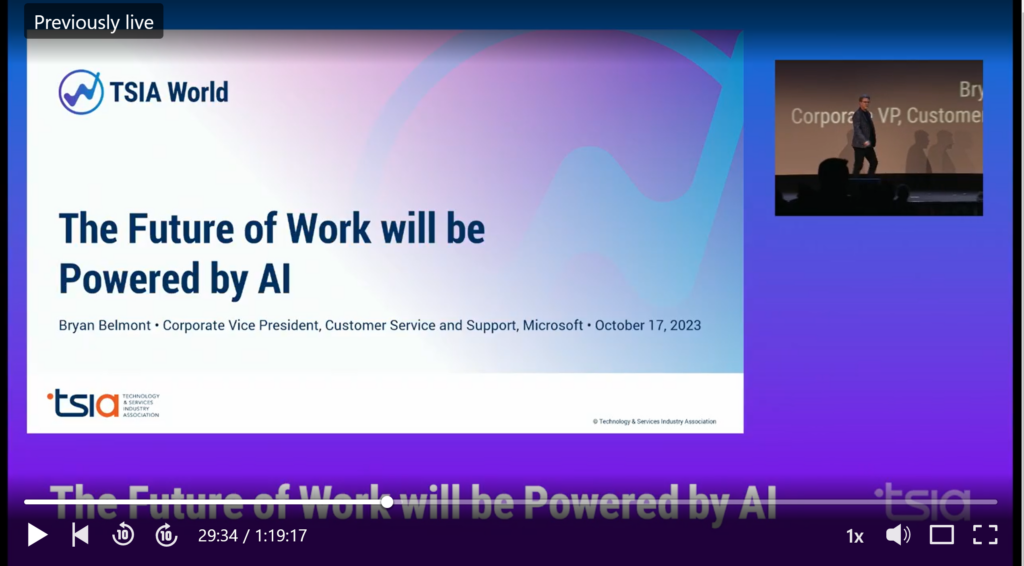
“Said the river: imagine everything you can imagine, then keep on going.” -Mary Oliver
I had the great privilege of hearing a trusted client of mine speak last month at the TSIA World Envision Event in Las Vegas. His speech changed my view of the past, present, and future.
Bryan Belmont is the Corporate Vice President for Microsoft Customer Service & Support. He serves a worldwide team of technical professionals focused on helping customers and partners to achieve more. He is one of the best strategists many have ever worked with, and his thinking is based on principles that scale across organizations and industries.
In this 20-minute presentation (Bryan starts his presentation at 29.18 minutes), Bryan stimulated provocative thinking about strategic technology impacts in the immediate future. The four sections include A Brief History of AI, The Impact of AI, Delivering Business Impact with AI, and The Value and Risks of Quantum Computing. While these were the topics, the message was even bigger.
The Future is now …

Key Notes for Leaders
-
- Secular shifts and change have always been a part of life but we are on a path of acceleration and the gap between change events is much shorter than it used to be.
-
- As leaders, we need to strategize for societal, ethical, and human change as well as Workforce Impact in order to scale these changes.
-
- Microsoft has a People+AI initiative. We all need to be looking at the human side more than the technology side of this change and manage it or it won’t deliver the value it is capable of and the balance between what we hope and fear will not tip in our favor (accessibility, equality, workforce reduction).
-
- Start conversations and planning that can’t wait. Quantum Computing is that conversation now. It can take problems that used to require hundreds of years to solve and do it in minutes. The risks and rewards are bigger than we can imagine.
-
- These conversations and this balance of short-term impact, with longer-term paradigm shifts, are fundamental. Given the acceleration of change in our current landscape, these cannot be handled sequentially but simultaneously and in parallel.
As I was listening, I felt the tension building until Bryan spoke about how monumental it is to be standing in this place in time! Whenever I feel like I am standing at the edge of what is possible, I get excited, and I think of the Visionary Framework I have been using with organizations for over 20 years (adapted from the original work of James Collins and Jerry Porras). I have pushed and pulled, led and followed, gathered and summarized the work of countless teams as they went about the important task of identifying what matters most in their organization. After listening to Bryan speak, I was even more committed to the importance of this and its relevance right now.
Is Your Vision Aligned With Where Your Organization is Going?
Elements of A Well Conceived Vision
Core Values
Clarity around values makes thriving during accelerated times of change possible. Core values are present, whether they are articulated or not, on your teams and in your organization. Get them on paper now because they provide alignment in a way that little else can. If they are not clear and used as a shared language, then people are not on the same page and often feel blindsided by “why” things are happening.
Core Purpose
A core purpose statement is about contribution and answers the question; What makes my work individually or collectively meaningful? This ideological foundation is critical but lacks meaning without the other side of the visionary framework which movement toward the future. The BHAG, supported by a strategy and description of what success looks like rounds out a well-conceived framework.
BHAG
The Big Hairy Audacious Goal timeline was shortened as I was listening to Bryan speak. While it is very important to think long term, long term may look more like 1-3 years versus 5-10 due to the acceleration of change events today. I would say the Quantum Computing dialogue and strategy is a BHAG for many industry leaders in technology and beyond.
Vivid Description of The Envisioned Future
This is what we need to write today. As leaders, this is the time to build this future vision before it builds itself. In order to ensure that the technology augments human capability and agency, this work is paramount.
Often when there is uncertainty, an organization will take on a more compressed outlook. The strength of this framework is that it provides alignment, inspiration, direction, and expansive thought in times of great change.
So, The Future Is Now
It is interesting that in physics, a quantum is the minimum amount of any physical entity (physical property) involved in an interaction (Wikipedia), and yet what is happening in quantum computing will take maximum effort and human capacity to harness and shape what is coming.
I still believe building a strong visionary framework is the fastest way possible to address this acceleration. The teams, organizations, and individual leaders who are clear on the elements of the framework will feel more excited than daunted by what is here and what is coming.
If/Then. This and That. Either/Or. Both/And. Past, Present, and Future. All of it. Now.
As Bryan said, the magic is “when technology augments human capability and increases our agency”. We need to work together to envision this future because the alternative is unimaginable and in a sense inevitable if we don’t have the vision and strategy to support what is, in many ways, already here. The future is now. As Mary Oliver penned, “Imagine everything you can imagine, then keep on going.”
Leave a Reply